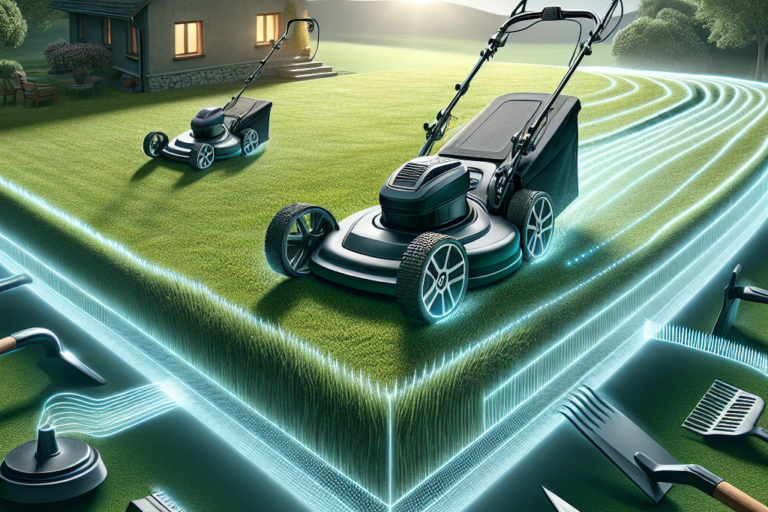Have you ever wondered how electric lawn mowers work? Well, wonder no more! In this article, we will demystify the inner workings of these modern marvels of gardening technology. From the powerful electric motors that replace traditional gas engines to the innovative battery systems that keep them running smoothly, you’ll discover the fascinating mechanics behind electric lawn mowers. So, grab a refreshing beverage, sit back, and prepare to be enlightened on the wonders of electric lawn mowers!
The Basics of Electric Lawn Mowers
Introduction to electric lawn mowers
Electric lawn mowers are a popular choice for homeowners who desire a cleaner, quieter, and more environmentally friendly way to maintain their lawns. These innovative machines utilize electric motors to power the cutting blades, eliminating the need for gas or oil. In this article, we will explore the various components, power sources, cutting mechanisms, safety features, maintenance requirements, and the pros and cons of electric lawn mowers. By the end, you will have a thorough understanding of these machines and be well-equipped to choose the right electric lawn mower for your needs.
Components of an electric lawn mower
Electric lawn mowers consist of several key components that work in unison to provide efficient and effective grass cutting. The main components include the electric motor, cutting mechanism, power source, height adjustment mechanism, grass collection system, and safety features. Each component plays a vital role in the overall performance and functionality of the mower.
Power source for electric lawn mowers
The power source is a crucial aspect of electric lawn mowers. Unlike their gas-powered counterparts, electric lawn mowers use either a cord or a battery to supply the necessary power to the motor. The choice of power source depends on various factors such as the size of the yard, the desired mobility, and the convenience of use. Understanding the power source options will help you select the right electric lawn mower for your specific needs.
Understanding the Power Source
Electricity as the main power source
When it comes to electric lawn mowers, the most common power source is electricity. Electric lawn mowers that operate via a cord require a nearby electrical outlet and the use of an extension cord. These mowers provide unlimited runtime and are ideal for smaller lawns. On the other hand, battery-powered electric lawn mowers offer greater mobility and do not require a cord. However, battery life can be limited, and recharging is necessary.
Types of batteries used in electric lawn mowers
Battery-powered electric lawn mowers utilize rechargeable batteries as their power source. There are two main types of batteries commonly used: lead-acid batteries and lithium-ion batteries. Lead-acid batteries are more affordable but are heavier and have a shorter lifespan. In contrast, lithium-ion batteries are lighter, have a longer lifespan, and offer more consistent power. Understanding the differences between these battery types is important when selecting an electric lawn mower.
Charging and maintaining the battery
Proper charging and maintenance of the battery are essential for the performance and longevity of the electric lawn mower. It is important to follow the manufacturer’s guidelines regarding charging time, avoiding overcharging, and storing the battery correctly. Regular maintenance, such as cleaning the battery terminals and checking for any signs of damage or wear, will ensure optimal performance and prolong the battery’s lifespan.

Electric Motor Types
Brushed electric motors
Brushed electric motors are commonly found in electric lawn mowers. These motors utilize mechanical brushes to transfer electricity to the rotating coil, creating the necessary magnetic field for the motor to operate. While brushed motors are cost-effective and widely available, they tend to be less efficient, generate more heat and noise, and require more maintenance due to the brushes requiring regular replacement.
Brushless electric motors
In recent years, brushless electric motors have gained popularity in electric lawn mowers. Unlike brushed motors, brushless motors eliminate the need for brushes by using electronic circuits to control the motor’s operation. This results in increased efficiency, reduced heat and noise generation, and longer lifespan. Although brushless motors may come at a higher price point, their numerous advantages make them a worthwhile investment.
Comparison of brushed and brushless motors
When comparing brushed and brushless motors, it becomes evident that brushless motors offer significant benefits over their brushed counterparts. Brushless motors are more energy-efficient, provide smoother operation, and require less maintenance. Additionally, brushless motors have a longer lifespan and are generally more durable. While brushed motors may still be suitable for smaller lawns or occasional use, brushless motors provide superior performance and reliability for larger or more frequent lawn maintenance.
Cutting Mechanisms
Rotary cutting blades
Rotary cutting blades are the most common type of cutting mechanism used in electric lawn mowers. These blades spin horizontally and use a forceful cutting action to trim the grass. The blades have a curved shape and multiple cutting edges that efficiently cut through the grass blades, resulting in a clean and even cut. Rotary cutting blades are suitable for most types of grass and provide effective results for a wide range of lawn sizes.
Cylinder cutting systems
Cylinder cutting systems, also known as reel mowers, utilize a series of sharp blades arranged in a cylinder-like configuration. As the mower moves forward, the blades rotate against a stationary bottom blade, trapping and cutting the grass between them. This cutting mechanism provides a precise and scissor-like cut, making it ideal for fine lawns such as golf courses or formal gardens. Cylinder cutting systems are often found in manual or electric push mowers.
Advantages and disadvantages of each cutting mechanism
Both rotary cutting blades and cylinder cutting systems have their advantages and disadvantages. Rotary cutting blades are versatile, suitable for most grass types, and can handle various lawn conditions. They are also more forgiving of obstacles and uneven terrain. On the other hand, cylinder cutting systems provide a neater and more professional finish, but they require a flat and even lawn surface for optimal performance. Additionally, cylinder cutting systems may struggle with taller or tougher grasses.

Safety Features
Electric safety switches
Electric lawn mowers come equipped with safety switches that prevent the motor from running unless certain conditions are met. These switches are often located on the handle, ensuring that the mower stops immediately when released. Electric safety switches protect against accidental starts and provide peace of mind while operating the mower.
Blade stop systems
Blade stop systems are another important safety feature in electric lawn mowers. These systems ensure that the cutting blades come to a complete stop within seconds after the safety switch is disengaged or when the handle is released. Blade stop systems minimize the risk of injury when inspecting or cleaning the mower.
Overload protection
To prevent the motor from overheating or burning out, electric lawn mowers are equipped with overload protection. This feature automatically shuts off the motor if it becomes overloaded, such as when cutting through tall or dense grass. Overload protection prolongs the lifespan of the motor and maintains its performance.
Other safety features
In addition to electric safety switches, blade stop systems, and overload protection, electric lawn mowers may have other safety features such as child lock mechanisms, safety key systems, or blade shields. These safety features provide an extra layer of protection and ensure safe operation, especially in households with children or pets.
Height Adjustment and Grass Collection
Height adjustment mechanisms
Height adjustment mechanisms allow users to customize the cutting height of the lawn mower. Most electric lawn mowers offer multiple height settings that can be easily adjusted to accommodate different grass lengths or desired lawn aesthetics. These mechanisms may involve manually adjusting the cutting deck or using a lever to change the height.
Methods of grass collection
Electric lawn mowers offer different methods of grass collection, including rear bagging, side discharge, and mulching. Rear bagging involves a bag attachment at the back of the mower, which collects the cut grass for later disposal. Side discharge allows the grass clippings to be expelled from the side of the mower, providing quick and efficient cutting with no need for grass collection. Mulching, on the other hand, finely chops the grass clippings and redistributes them back onto the lawn, acting as a natural fertilizer.
Mulching capability of electric lawn mowers
Mulching capability is an important consideration for those looking to promote a healthy and lush lawn. Electric lawn mowers equipped with mulching capability finely shred the grass clippings and evenly distribute them on the lawn. This process not only eliminates the need for collecting and disposing of clippings but also returns valuable nutrients to the soil, fostering the growth of healthier grass.
Efficiency and Performance
RPM and cutting speed
Efficiency and cutting performance are influenced by the revolutions per minute (RPM) and cutting speed of electric lawn mowers. Higher RPM and cutting speeds result in quicker and more effective grass cutting. The RPM can vary depending on the specific model and cutting mechanism, so it is essential to consider these factors when evaluating the efficiency and performance of an electric lawn mower.
Operating time and battery life
For battery-powered electric lawn mowers, operating time and battery life are crucial considerations. Operating time refers to the length of time the mower can run on a single charge before requiring recharging, while battery life refers to the overall lifespan of the battery itself. Longer operating times and extended battery life ensure uninterrupted and efficient lawn maintenance, especially for larger yards.
Noise level comparison with gas lawn mowers
One notable advantage of electric lawn mowers over gas-powered ones is their significantly reduced noise level during operation. Electric motors generate much less noise, providing a quieter and more enjoyable mowing experience without causing disturbance to neighbors or family members. This is particularly beneficial for those living in noise-sensitive areas or seeking a more peaceful environment.
Maintenance and Care
Cleaning the mower
Regular cleaning is essential to ensure the optimal performance and longevity of an electric lawn mower. After each use, it is recommended to remove any debris, grass clippings, or dirt that may have accumulated on the cutting deck, blade, or housing. This can be done using a brush or compressed air. Cleaning the mower prevents buildup and corrosion, ensuring smooth operation and preventing potential issues.
Blade sharpening
Maintaining sharp cutting blades is crucial for achieving a clean and precise cut. Over time, the blades can become dull or damaged, leading to unsatisfactory cutting results. Electric lawn mower blades can be sharpened using specialized blade sharpening tools or by taking them to a professional. Regular blade sharpening, typically once or twice a season, will keep the mower operating at its best.
Regular battery maintenance
For battery-powered electric lawn mowers, regular maintenance of the battery is necessary to ensure optimal performance. This includes cleaning the battery terminals to remove any dirt or corrosion, checking the battery connections, and inspecting the battery for signs of wear or damage. Following the manufacturer’s guidelines for battery maintenance will help maintain its performance and extend its lifespan.
Storage considerations
Proper storage of the electric lawn mower is essential to protect it from moisture, dust, and other elements that can compromise its functionality. Before storing the mower, it is advisable to clean it thoroughly, ensure that the battery is properly charged or removed if applicable, and consider covering it with a protective cover. Storing the mower in a dry and secure location will help ensure its longevity.
Pros and Cons of Electric Lawn Mowers
Advantages of electric lawn mowers
Electric lawn mowers offer numerous advantages that make them an attractive option for homeowners. They are eco-friendly, producing zero emissions and reducing the carbon footprint. Electric mowers are also quieter, providing a more peaceful mowing experience. They require less maintenance compared to gas-powered mowers, eliminating the need for oil changes, spark plug replacements, or carburetor adjustments. Additionally, electric mowers do not require the storage of flammable fuels, making them safer to use and store.
Disadvantages of electric lawn mowers
While electric lawn mowers offer many advantages, there are some limitations to consider. Battery-powered mowers may have limited runtime, necessitating recharging or carrying a spare battery for larger yards. Electric mowers with cords may have restrictions on mobility and require a nearby electrical outlet. Moreover, electric lawn mowers may not be as powerful as gas-powered ones, making them less suitable for tackling dense or overgrown grass. It is important to weigh these limitations against the benefits to determine if an electric lawn mower is the right choice for your needs.
Choosing the Right Electric Lawn Mower
Considerations based on yard size
When choosing an electric lawn mower, the size of your yard is a significant factor to consider. For smaller yards, a corded electric mower may be sufficient as it provides unlimited runtime and is generally lighter and more affordable. However, for larger yards, a battery-powered mower with a longer operating time or the ability to interchange batteries may be more suitable. Understanding the size of your yard will help you determine the necessary features and capabilities for efficient lawn maintenance.
Additional features to look for
In addition to considering the power source and cutting mechanism, there are several additional features that can enhance the functionality and convenience of an electric lawn mower. These features may include adjustable handles for increased comfort, foldable designs for easier storage, easy-access grass collection bags, or LED indicators for battery level monitoring. Assessing your specific needs and preferences will help you identify the additional features that are most important to you.
Budget considerations
Budget considerations play a crucial role in choosing the right electric lawn mower. Electric mowers generally have a wide range of prices depending on the brand, features, power source, and cutting capabilities. It is important to establish a budget range and prioritize the features that are essential to your lawn maintenance needs. Conducting research, comparing prices, and reading customer reviews will help you make an informed decision that aligns with your budget while meeting your requirements.
In conclusion, electric lawn mowers provide a cleaner, quieter, and more sustainable alternative to traditional gas-powered mowers. Understanding the various components, power sources, cutting mechanisms, safety features, maintenance requirements, and pros and cons of electric lawn mowers is essential for making an informed decision. By considering factors such as the size of your yard, desired features, and budget, you can select the right electric lawn mower that will efficiently and effectively maintain your lawn while minimizing environmental impact and maximizing convenience. With their advancing technology and increasing popularity, electric lawn mowers are revolutionizing the way we care for our lawns and contributing to a greener future.



